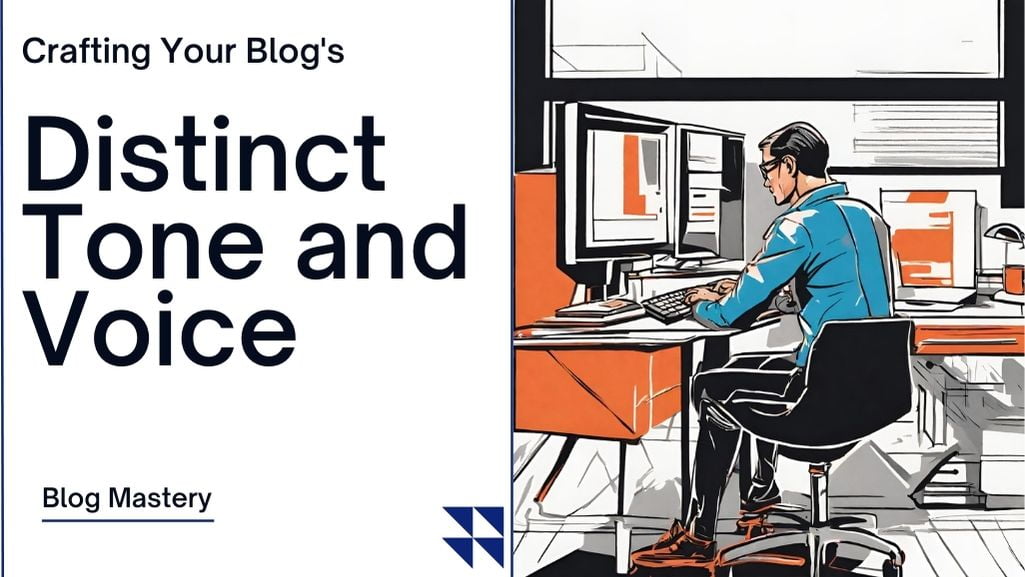Voice and tone in your blog aren’t just popular terms; they’re what make your words memorable.
Get this right, and you’ll turn random visitors into loyal followers fast.
We’re here to explain the basics of voice and tone to help your blog be noticed.
It’s all about giving your writing a one-of-a-kind personality that connects—let’s start.
Defining Blog Voice and Tone
Alright folks, let’s hash out the crux of crafting killer blog content: Voice and Tone.
Miss the mark on these, and no amount of social media icing or SEO sprinkles will sweeten your bland buffet enough for readers to bite.
So what’s the recipe for irresistible content? Read on.
What is Voice and Why Does It Matter?
Your blog’s voice is that signature style – the audible fingerprint woven through all expressions that screams, “It’s me!” The instant readers hear your distinct voice, they recognize the content they’re diving into belongs to you.
This familiarity hooks readers, transforming one-off drive-bys into long-term VIP members quicker than Thanksgiving leftovers disappear. Because when fans come to rely on your authentic voice as a promise of what to expect, a loyalty emerges beyond what any algorithm can decode.
Sure – you can play keyword bingo and chase trends.
But a disjointed stream with no cohesive voice?
Might as well throw content darts blindfolded and pray.
No consistency means no identity.
Just a disjointed sales pitch that bounces off readers like bricks.
But… When your content flows with a steady signature voice aligning to your brand ideals?
You magnetize that audience, baby. They intrinsically vibe with your mission because your voice roots them in shared values and a cultural kinship.
What Does Tone Mean and What is Its Significance?
Tone aligns your voice across contexts through precise emotional tailoring. Chameleon-like, it flexes to match post formats, audience traits and communication goals fluently.
While voice may persist as your blog’s steadfast identity, tone provides the range. It allows your fixed personality to shift tones as needed – from formal authority to humorous takes, empathetic counsel to conversational chats.
Without tonal awareness? You constantly misfire messages.
Imagine somber reactions to uplifting stories or flippant responses to crises.
Envision the reader wrath.
But master tone, and your reactions resonate every time.
You earn audience ears because they sense your voice genuinely meeting situational norms.
In short, consistent voice fused with adaptive tone gives your blog influence beyond measure. It says you respect diverse realities. And respect builds reader trust.
So there you have it, folks. Voice and Tone – the secret ingredients for stirring up content that sticks.
First whip up an authentic voice that aligns to your brand essence. Then fold in adaptive tones to flex that signature style across contexts.
Do this, and your content will have readers licking their lips for more of your distinctive flavor.
Now that you’re savvy on why Voice and Tone matter, let’s get cookin’ on the recipe for finding your own irresistible blogging voice.
Just like a magical potion, the precise ingredients and steps result in wizard-like powers of influence.
I’ll walk you through it…
Finding Your Authentic Blogging Voice
Crafting a magnetic blog voice that woos readers like a siren song starts with soul-searching.
We must plunge within to extract what uniquely defines us – our credo, our essence.
That rare elixir blending ideals, interests and individuality into influential expression.
So let’s get existential, folks.
Define your truth.
What vision do you champion even when others deem you delusional?
We each cling passionately to causes aligning with our inner compass.
Mine is a world where all can thrive being unapologetically themselves.
What’s yours?
Know Yourself – Clarify Your Values, Beliefs, Interests
Start by assessing what potential excites you.
Are you stoked by AI’s promise yet leery of its perils?
Do you dream of accessing education’s power yet despise its politicization?
Pinpoint where you stand.
Next, spotlight personal passions.
What niche hobbies enthrall you?
I’m enamored with electronic music and fantasy fiction, revealing values around innovation, creativity and escapism.
Furthermore, become conversant in chosen fields through continual curiosity.
I inhale content on behavioral psychology, philosophy, and digital marketing.
This specialized knowledge lets me fuse facts with conviction when articulating perspectives.
Finally, identify issues outraging your sense of justice.
Define where you stand for causes bigger than yourself.
Compile the above into a list highlighting interests, values and change-driving issues worthy of championing through your writing. This self-knowledge breathes authenticity into your blog voice.
Embrace Your Personality and Let It Shine Through
Next, embrace your personality.
Are you outspoken or soft-spoken? Cerebral or silly? Serious or satirical?
Jot adjectives capturing your essence.
Defy dichotomy by embracing the multitudes within you.
I poke holes in assumptions yet propose unorthodox alternatives.
I question status quos yet provide practical solutions.
I blend reason with playfulness and facts with feeling.
So give yourself permission to accentuate those personality aspects through writing.
Boldly declare stances with conviction.
Poke fun at pet peeves.
Enthuse sharing niche passions.
Such amplification builds reader connection, announcing “I give few fucks if you disagree because I stand for something.” It wins trust by baring imperfections and quirks cultivated over a life messily lived.
In short, voice brews by blending interests, values, and personality into writing.
So brew an irresistible elixir – your signature blog voice!
Yet who will this distinct flavor attract?
The most alluring elixir remains mere potential without worthy imbibers.
So now we must curate an audience whose palettes will relish your unique brew.
Read on as we explore audience targeting essentials for maximizing those your voice magnetizes!
Understanding Your Audience
Want content that has a lot of influence?
Then first understand those you want to convince like an artist studies their subject, looking at every detail and complexity that makes up who they are.
Look past basic demographics to get to know the more personal psychographics that guide behavior – the hidden hopes and interests that control how they interact with the world.
Only by really getting to know these deeper qualities can you make a connection as strong as old friends, brought together by understanding each other.
But where do you start getting these insights?
Few people walk the streets doing random surveys. And even if they did, would surface traits really show everything going on inside?
Identify The Reader Persona You Want to Attract
Start audience research by gathering concrete demographic information – measurable attributes like age, gender, location, income and education that describe the group. This forms the basic skeleton that psychographic insights will later fill out into a complete profile.
While these statistics offer helpful high-level info, more investigation is needed to truly understand your audience. Just like an iceberg’s visible top doesn’t hint at what lies underwater, do surface traits really show the many complex things driving people?
So we need to go deeper – into the constantly changing psychology guiding them.
What personal values and interests define them?
What issues do they care about?
How have their unique life experiences shaped how they see the world and their role in it?
Grasping these inner motivations allows you to connect over shared perspectives – highlighting overlapping truths you both naturally agree with because of similar life events that shaped you.
For instance, maybe childhood troubles made them passionate advocates for equal access to education no matter obstacles like poverty or unfair treatment.
That common ground links writer and reader in a shared vision of what matters, rooted in turning past powerlessness into current purpose.
When life experience drives content creation, its true resonance comes through automatically.
Also, use focus groups and surveys to continuously refine your audience understanding over time.
Test content samples with target readers, closely reviewing reactions. When do their eyes light up with excitement, brains tickled by words capturing their feelings?
When do they frown with confusion from not quite getting it?
Concrete feedback reveals gaps between your assumptions about them and the reality.
Filling those gaps through repeated research ensures your content evolves to meet their changing needs.
Appeal To Your Audience By Speaking Their Language
Additionally, closely study language already working with your readers.
Look at idioms that emotionally connect by referring to cultural touchpoints.
Spot shared experiences tapping their nostalgia, be it 80s pop culture or niche historical events.
Pinpoint humor that makes them laugh – wry irony, slapstick wit, deadpan snark.
The possibilities are endless.
Also closely study influencers already winning their loyalty. Echo speech patterns of favorite thought leaders in your writing – sentence structures, word choices, speed and tone triggering psychological comfort as readers hear familiar voices saying You belong here.
Experiment with language variables to discover ideal resonance.
Try short punchy bursts.
Relish lengthy lyrical prose.
Sprinkle in humor or dial it down.
Test which vocabulary complexity makes things clear versus confusing.
This concrete feedback shows the communication style uniquely matched to their minds.
Your content now rings true by wholly reflecting their essence back at them.
We deeply grasp core qualities like their entrepreneurial spirit, scrappy resourcefulness and community-building ideals that when highlighted through deliberate tone and word selections, crafts messages transformed into symphonies – the writer and reader bonded by the harmony of mutual understanding.

Selecting The Appropriate Tone and Diction
We’re taking a fast tour from looking deep into audience brains all the way through matching words and emotions to precisely target their hearts.
Miss a turn, and your writing crashes from confusion faster than a first-time driver on a race track.
But follow my guide, and your words connect deeper than loud bass music, earning loyalty longer than the long wait for the next Game of Thrones book.
So start your engines and let’s go!
First: research. While basic reader facts help, we’ve gotta dig deeper into what guides people to take action.
Their motivations. Interests. Values. Beliefs.
Understanding these hidden reasons behind choices allows us to bond through shared perspectives – that natural feel of “You get me.”
It also helps us spotlight similar views between writer and reader naturally agreed on because of alike past events shaping opinions.
Like both giving to equal rights groups after facing hardship.
Such built-in links based on shared experiences connect us by showing “We’re the same.”
Also closely study influencers already winning their support using things like speech patterns, word choices and speed/tone causing psychological coziness. Such well-known voices quietly signal, “You belong here” as readers hear preferred thought leaders saying it.
Now let’s switch gears to using this knowledge. Armed with reader insights, we must apply that info through precise language tuning.
Carefully picked words and emotions matching tones are key for writing that connects faster than the last dinner roll disappearing at Thanksgiving.
Mix this up, and you might as well try selling heavy metal music to easy listening radio fans.
Match Your Diction To The Audience
We have to start by selecting vocabulary suiting our reader’s education and backgrounds.
Using lots of fancy complex words with everyday folks? You’ll lose ’em faster than the last bites of Thanksgiving turkey.
Gotta consider your crowd.
What dictionary defines their everyday talk?
See, insider groups all have their own language full of terms and slang.
Use those word patterns, and readers intrinsically relate to your writing by hearing their culture reflected.
It automatically says “You belong here.”
For example, fellow music makers nod when I reference technical terms.
Such exact words signal insider know-how without explaining basics I already grasp.
Show you understand my world.
Make me feel seen by speaking my language.
But overly scholarly writing baffles casual readers just wanting fun escapes rather than deep analysis.
So lifestyle bloggers connect through shared views and conversational words instead of distant debates full of academic complexity.
They relate through openness and self-sharing rather than an expert’s detached neutrality.
Also, use local sayings when targeting associated areas as they tap into readers’ home identities.
New Yorkers intrinsically get “fuggedaboutit” colorfully emphasizing points in a way outsiders may miss.
Texans appreciate phrases like “all hat and no cattle” as shorthand for phonies.
Such insider slang suits reader origins by speaking a common tongue.
So tactically include or avoid niche slang based on your audience.
Carefully switch phrasing and vocabulary for each subgroup.
This makes your content more readily clear, organically engaging groups by echoing their community’s familiar voices.
This establishes psychological coziness through reflections of their identity in your writing style, word choices and phrasing – making an experience of belonging by tailoring content to their self-image.
Adapt Tone To Suit The Situation and Content Type
Also, correctly adapting tone aligns reader reactions with underlying goals.
For instance, seriously share important company news involving big choices to convey importance while limiting worry.
Directly quote executives, adding weight to new rules.
Explain expected changes in precise detail, preparing audiences for adjustments.
Such straightforward information focused on practical results provides clear direction without room for speculative interpretations that may cause concern. It puts reader experience first, aiming to simplify transitions by directly addressing needed actions rather than causing confusion.
In contrast, inject enthusiasm, urgency, and buzz when announcing plans meant to energize audiences like product launches.
Celebrate awesome capabilities customers demanded for years. Rave about inventive features moving the industry forward.
Build anticipation by highlighting reviewers already praising it as revolutionary. Have executives openly share passion-filled visions focused on user needs.
Such an upbeat, electric tone generates excitement and pulls attention toward the offering by matching the desired emotional response – triggering thrill and curiosity.
In both examples above, the tone sharply changes from the content type while matching underlying objectives – be that conveying importance amidst change, or stirring up anticipation around launches.
This adherence to purpose over convention shows awareness of audience-focused writing – fine tuning tones to guide experiences rather than sticking to one static style.
Such flexibility earns reader trust by providing content catered to expectations.
So to recap, closely tailoring tone and word choice to audience psychographics makes content intrinsically resonate by reflecting their essence through familiar voices and precision language. Such care wins loyal fans eager to hear more of your distinct perspectives.
But keeping such commitment risks fragmentation when funneling that signature voice across multiple content types like video, podcasts, and social updates.
How do we adapt style across formats while preserving what fans love?
Well get ready – we’ll uncover key ways to achieve multi-channel cohesion!
From crafting content guidelines protecting your voice to building flexibility allowing tonal shifts, I’ll share vital unity across distribution methods.
We’ll dig into this and more regarding unity across channels soon!
Achieving Consistency Across Channels
Alright folks, here’s the inside scoop on uniting your content across channels without diluting your signature spice:
Sticking to the same flavor risks folks thinking your menu lacks variety. But if you’re constantly changing recipes, your restaurant becomes forgettable.
So here’s how to balance dishes aligned with your essence yet flexible across courses.
Create an Editorial Style Guide For Your Brand Voice
First, become the universal chef by writing The Sacred Cookbook codifying special ingredients comprising your voice so ghostwriters can bake your essence into any content format.
Define your point-of-view, key phrases, word choices and other elements writers should stir in so readers intrinsically taste your distinct perspective across channels – like my tendency to question assumptions or practically weave emerging concepts into relatable analogies.
This comprehensive recipe guide empowers external chefs to faithfully recreate your flavor versus loosely interpreting your vibe based on vague impressions. They’ll reliably echo your worldview by following defined directives, not improvising based on loose interpretations.
Build Flexibility To Adapt Tone Across Content Formats
However, flexibility remains key across diverse courses.
An ultra-conversational casualness fitting blog posts risks undermining eBook formality expectations.
Similarly, a motivational newsletter’s optimism contrasts with a financial report’s objectivity needs.
So empower content teams with the decentralized authority to appropriately shift peripheral elements like diction, cultural references and humor while retaining adherence to foundational perspective pillars. This balances continuity on core identifiers with adaptability on secondary tone elements across formats.
Such built-in variety focuses voice consistency around differentiating worldviews while allowing fluid format-specific adjustments targeting context norms. This keeps messaging reliably relatable across diverse touchpoints without fragmented experiences diluting your essence.
However, even a well-defined voice risks fading into irrelevance without continual cultivation.
Because language evolves. Cultural trends change. And audience tastes shift.
What emotionally connects today may disconnect tomorrow.
So while cross-channel alignment remains crucial, ongoing refinement also proves vital so your distinctive voice and tone grow in relevance rather than going stale.
Because who wants content as outdated as parachute pants and mullet hairstyles?
To discover key ways to evolve your blog voice over time, read on!
Evolving Your Voice Over Time
Folks, if we’re not moving forward online, we’re falling behind faster than ice melts in summer.
The internet keeps changing like the weather.
So staying popular means always stirring things up so your stuff keeps getting attention rather than becoming forgettable.
I’ll explain…
First, track big voices to see what’s hot now versus what’s gotten old.
Next, reader feedback shows soft areas needing a voice lift.
Do both a lot and your words stay delicious as fudge on ice cream.
Ignore it and get ready for low readership longer than the wait for those Game of Thrones books.
Let’s start!
Brew up inspiration by following top bloggers in your niche. Closely compare their posts, studying approaches over time. Look at changes in how they write, references they make, humor type and more.
This shows what tweaks work to hook fans.
For example, many lifestyle bloggers blend personal stories with useful facts.
This makes heavy stuff more engaging by giving logical and emotional hooks.
Study such mixing to create your own tasty fusion style.
Likewise, track their engagement levels. If certain styles gain momentum, this highlights useful updates to borrow.
Echo popular topic or tone changes in your own voice to ride what’s trending. It’s like having a famous DJ remix your song to reach new crowds.
But directly ask readers for the clearest changes guidance through polls or focus groups.
Use rating scales to see which variables emotionally connect strongest. For instance, have them compare content samples with different humor levels.
Numbers show what resonates for doubling down.
Also, ask open-ended feedback on confusing parts needing modernization. Then, improve those spots.
If analysis shows declining interest in former favorite subjects, retire those stale ingredients for fresher flavors.
Blend these external insights with your core perspective for updated takes feeling familiar yet fresh.
It keeps content evolving without an identity crisis.
Soon fans crave your signature flavor awaiting the next bite.
There it is folks – the recipe for continually developing an influential voice tuned to the times.
What other ever-changing internet mysteries perplex you? Let me know and we’ll tackle those next!
Closing Comments
Your blog’s voice and tone are key; they’re how you make a strong impression. Get them right to turn visitors into regulars.
Be real; let the real you guide your posts, and change your tone for different situations.
Always be set to evolve and grow; that’s how you stay popular online.
Put this help into action, write with a goal, improve your message, and you’ll make a community that’s eager to hear what you have to say.



